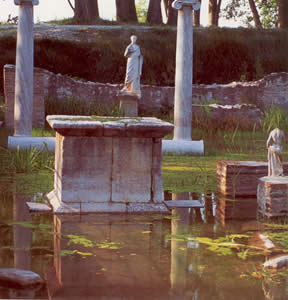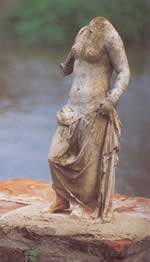Dion Archaeological Park; open 8am-7pm daily; 2.35;1.20 adult/student.
 At the foot of Mt. Olympus, north of Litohoro. The sacred city of the ancient Macedonians; a city of sanctuaries. Dion was built on a harbor before the river dried up (as did the river at Pella).
At the foot of Mt. Olympus, north of Litohoro. The sacred city of the ancient Macedonians; a city of sanctuaries. Dion was built on a harbor before the river dried up (as did the river at Pella).
It was here that both Philip II and Alexander came to make sacrifices to Zeus before setting out on their campaigns. The name is from Dion/Dios/Dias—another name for Zeus.
There is evidence that a fertility goddess was worshipped here in earlier times (and, interestingly, Demeter, goddess of grains, during Macedonian times).
Others included Asclepius, god of healing, and Isis, the Egyptian goddess, whose votive statues were found surprisingly intact.
The town of Dion was evacuated during the fifth century AD during an earthquake and then inundated with mud that slid down the mountain. In present times it is still wet and requires pumping to dry it out.
 The site is noted for its mosaics, which were found in a dining hall, one of which shows Dionysos on a chariot; its public baths and its sanctuaries of Demeter and Aphrodite-Isis.
The site is noted for its mosaics, which were found in a dining hall, one of which shows Dionysos on a chariot; its public baths and its sanctuaries of Demeter and Aphrodite-Isis.
The theater remains are used for performances during the Olympic Festival in summer.
The site museum is located in the village of Dion, and is open 8am-7pmTues-Fri;12:30pm-7pm Mon;2.35 euros) with labels in both Greek and English. The sculptures were preserved by the mud-flows that destroyed the area.
There is a mosaic of Medusa in the basement, but must be viewed from the stairs above it. Upstairs are objects of everyday life, as well as pottery and coins. There is also a first century BC pipe organ. There are campsites on the beach at Variko, 11km/6.8miles away and there are rooms in Dion.